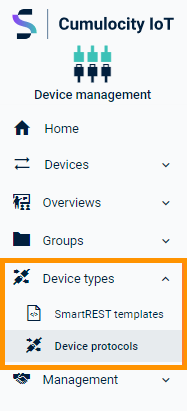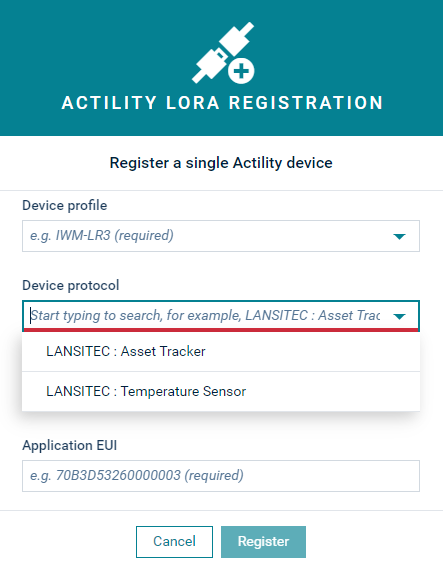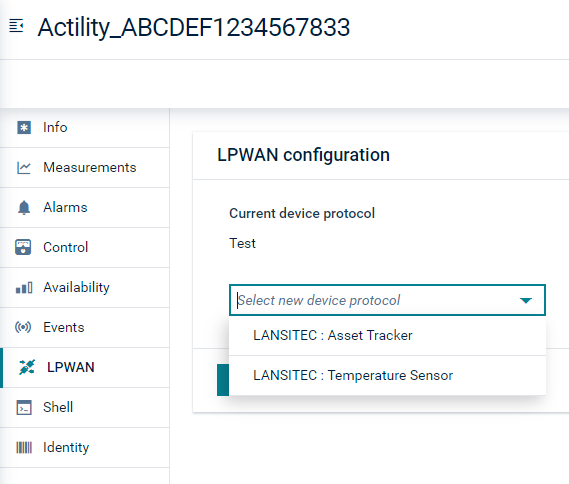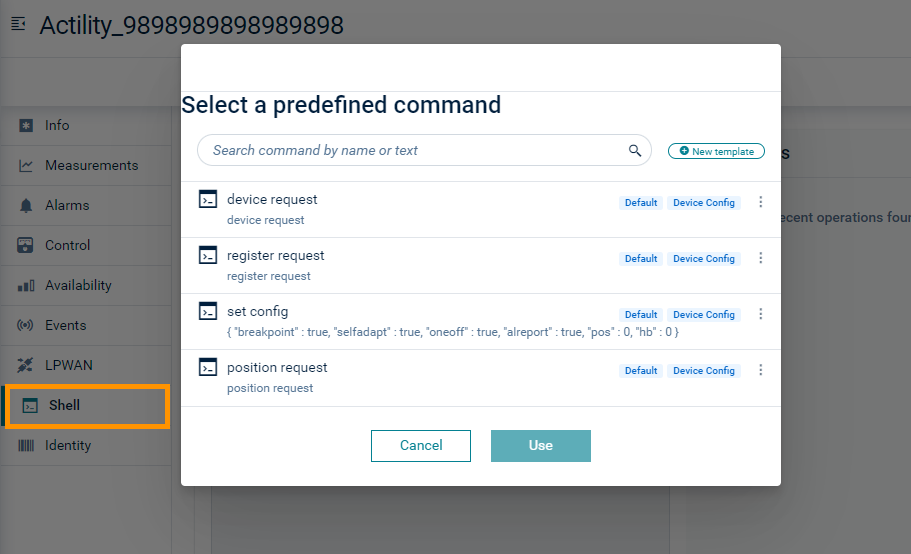Overview
Cumulocity IoT can interface with LPWAN devices through LPWAN network providers via Cumulocity IoT LPWAN agents, such as Actility LoRa.
Our LoRa integration allows you to define device protocols in a self-service manner to create a binary mapping of the LoRa sensor data to the Cumulocity IoT data model. However, this approach does not work for LoRa devices sending dynamic payloads. To integrate LoRa devices with dynamic payloads, a custom codec for payload decoding and command encoding can be created in form of a microservice. This microservice will be referred to as a custom codec microservice. A custom codec microservice is a typical Cumulocity IoT microservice which conforms to a specific contract for decoding and encoding LoRa payloads and commands.
When an LPWAN agent receives an uplink message, it forwards the device data to a REST endpoint (such as /decode) exposed by the custom codec microservice for decoding.
Similarly, when the user executes a device command through the device shell, the LPWAN agent forwards the command text to a REST endpoint (such as /encode) exposed by the custom codec microservice for encoding.
To learn more about working with LPWAN custom codec, see the following sections:
- Implementing a custom codec microservice - How to implement a custom codec microservice that conforms to the predefined contract.
- Using the lpwan-custom-codec library - How to implement a custom codec microservice using the lpwan-custom-codec library.
- Deploy the sample codec microservice - How to deploy the sample codec microservice.
Implementing a custom codec microservice
A custom codec microservice is a typical Cumulocity IoT microservice, which can be implemented and enabled as follows.
-
Create a microservice which exposes the /encode and /decode REST endpoints conforming to the OpenAPI Specification, implementing the encoding and decoding functionality.
-
The microservice needs to create device protocols for each LPWAN device type it supports. If you use the lpwan-custom-codec library the device protocols will be created automatically for you. Otherwise, you must use the Inventory API to create a new managed object describing the device protocol with the following JSON structure:
You must create a device protocol (with
typeandfieldbusTypeproperties, and thec8y_LpwanCodecDetailsfragment) as well as an external ID for every device manufacturer and device model combination that this codec microservice supports:typeis always “c8y_LpwanDeviceType”.fieldbusTypeis always “lpwan”.- The
c8y_LpwanCodecDetailsfragment contains:codecServiceContextPath- Custom codec microservice context path.supportedDevice- Supported device information.deviceManufacturer- Device manufacturer.deviceModel- Device model.
supportedDeviceCommands- A list of commands which this device supports:name- Command name, matching the name of the predefined command template you create (see below).category- Command category, matching the category of the predefined command template you create (see below).
Example for the JSON structure for creating a device protocol using the Inventory API:
{ "name": "<<Name of the LPWAN device protocol>>", "description": "<<Description of the LPWAN device protocol>>", "type": "c8y_LpwanDeviceType", "fieldbusType": "lpwan", "c8y_IsDeviceType": {}, "c8y_LpwanCodecDetails": { "codecServiceContextPath": "<<Custom Codec microservice context path>>", "supportedDevice": { "deviceManufacturer": "<<Supported device manufacturer>>", "deviceModel": "<<Supported device model>>", "supportedDeviceCommands": [ { "name": "<<Command name, matching the name of the Predefined Command template you create>>", "category": "<<Command category, matching the category of the Predefined Command template you create>>" } ] } } }Example for the JSON structure for creating an external ID for the device protocol using the Identity API:
{ "externalIds": [ { "managedObject": "<<ID of the Device protocol managed object>>", "externalId": "<<Device Protocol Name>>", "type": "c8y_SmartRestDeviceIdentifier" } ] } -
Based on the device protocol assigned to a device, the LPWAN agent automatically routes the request to the corresponding microservice. For device downlink commands, the LPWAN agent forwards the device shell command request to the /encode endpoint only when a predefined command listed as “supportedDeviceCommands” in the
c8y_LpwanCodecDetailsfragment of the device protocol is executed.You must create a predefined command template for every supported device command (
supportedDeviceCommands) specified in the device type.The following example shows the JSON structure for creating a predefined command template using the Inventory API:
{ "type": "c8y_DeviceShellTemplate", "name": "<<Command name, matching the name of the supported command mentioned in the device protocol>>", "deviceType": [ "<<Device Protocol Name>>" ], "category": "<<Command Category>>", "command": "<<Command string which gets copied to the device shell command prompt when the user chooses this Predefined command>>", "deliveryTypes": [ "Default" ] }
Using the lpwan-custom-codec library
For convenience, Cumulocity IoT provides the Java library com.nsn.cumulocity.clients-java:lpwan-custom-codec to develop the custom codec microservice in Java as a SpringBoot application.
When subscribed, such a custom codec microservice automatically creates the required device protocols and predefined command templates as described in Implementing a custom codec microservice.
To create a custom codec microservice using this library, do the following:
-
Create a Spring Boot application and annotate its main class with:
@CodecMicroserviceApplication `com.cumulocity.microservice.lpwan.codec.annotation.CodecMicroserviceApplication` -
Implement the following Java interfaces and annotate them with:
@Component `org.springframework.stereotype.Component`a. Implement the
supportedDevicesmethod ofcom.cumulocity.microservice.lpwan.codec.Codecto specify the device manufacturer, device name and the commands this custom codec service supports:```java package com.cumulocity.microservice.lpwan.codec; public interface Codec { Set<DeviceInfo> supportsDevices(); } ```b. Implement the
decodemethod ofcom.cumulocity.microservice.customdecoders.api.service.DecoderServiceto provide the decode functionality. The decode method receives the following input:inputData- device payload to be decoded.deviceId- device managed object ID.args- a map which contains keys:deviceManufacturer- device manufacturer.deviceModel- device model.sourceDeviceEui- device eui.fport- fport (optional).
The library also provides the wrapper class
com.cumulocity.microservice.lpwan.codec.decoder.model.LpwanDecoderInputDatato extract the decoder inputs.```java package com.cumulocity.microservice.customdecoders.api.service; public interface DecoderService { DecoderResult decode(String inputData, GId deviceId, Map<String, String> args) throws DecoderServiceException; } ```c. Implement the
encodemethod ofcom.cumulocity.microservice.customencoders.api.service.EncoderServiceto provide the encode functionality:```java package com.cumulocity.microservice.customencoders.api.service; public interface EncoderService { EncoderResult encode(EncoderInputData encoderInputData) throws EncoderServiceException; } ``` -
Add the following roles as
requiredRolesin the microservice manifest filecumulocity.json:"requiredRoles": [ "ROLE_INVENTORY_ADMIN", "ROLE_INVENTORY_READ" ]
Deploying the sample codec microservice
Steps to build the example codec lora-codec-lansitec microservice.
- Clone https://github.com/SoftwareAG/cumulocity-examples.git repository.
- Build the microservice using
mvn clean install. This creates a ZIP file of the lanitec codec microservice. - Deploy the microservice by uploading the ZIP file using the Cumulocity IoT Administration UI.
- Open the Device management application. Under Device protocols, you should now see the device protocols with type “lpwan” created by the lansitec codec microservice.
The image below shows the device protocols option in the Device management application.

The image below shows an example of the device protocols created by the custom codec microservice on subscription.

The created device protocols will be listed in the dropdown during the device registration of LPWAN with any of the LPWAN agents. The Actility LoRa device registration is shown below.

You can also assign the device protocol from the LPWAN device tab. To do so, navigate to a particular device. Then, switch to the LPWAN tab and click New device protocol to view the device protocols created above.

Supported device commands are available in the Predefined commands option from the Device shell tab.
